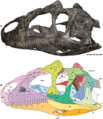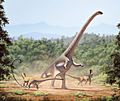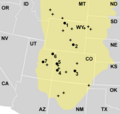Allosaurus facts for kids
Quick facts for kids Allosaurus |
|
|---|---|
 |
|
| Replica of Allosaurus skull (San Diego Natural History Museum). | |
| Conservation status | |
|
???
|
|
| Scientific classification | |
| Kingdom: | |
| Phylum: | |
| Superorder: | |
| Order: | |
| Suborder: | |
| Family: |
Allosauridae
|
| Genus: |
Allosaurus
Marsh, 1877
|
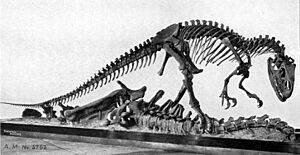
Allosaurus was a huge, meat-eating dinosaur that lived during the Late Jurassic period. This was about 155 to 150 million years ago! Imagine a giant, fierce bird with super sharp teeth and powerful claws – that's a bit like what Allosaurus was. Its name means "different lizard." This is because its vertebrae (backbones) were different from other dinosaurs known when it was found.
Allosaurus was a truly amazing dinosaur. Its strong body, sharp teeth, and hunting skills made it a very tough predator. By studying Allosaurus, we can learn more about the cool world of dinosaurs. We also learn about the ancient environments they lived in.
Contents
Allosaurus: What Did It Look Like?
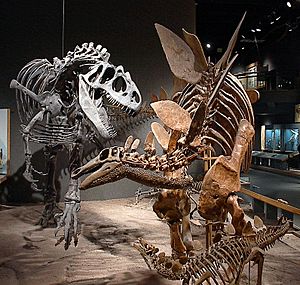
Allosaurus was a scary predator with some special features:
- Size: Allosaurus was a big dinosaur. It was usually about 8.5 meters (28 feet) long. But some fossils show they could grow up to 12 meters (39 feet) long! That's longer than a school bus!
- Weight: They weighed around 2.3 metric tons (2.5 short tons). This is about the same weight as a small elephant!
- Skull: Allosaurus had a large skull. It had bony crests above and in front of its eyes. These crests were probably for showing off. Maybe they helped attract mates or scare away rivals.
- Teeth: It had dozens of sharp, jagged teeth. These were perfect for tearing meat. These teeth were always being replaced. So, if one broke or fell out, a new one would grow in its place.
- Arms and Hands: Allosaurus had fairly short arms with three-fingered hands. The claws on its fingers were sharp and curved. They were great for grabbing and holding onto prey.
- Legs and Feet: It had strong, muscular legs. These let it run very fast. Its feet had three toes that carried its weight. These toes had large claws.
- Tail: Allosaurus had a long, heavy tail. This helped it balance while running and turning.
Where Did Allosaurus Live?
Allosaurus lived in North America. Specifically, it lived in what is now the western United States. Fossils of Allosaurus have been found in states like Colorado, Utah, Wyoming, Montana, and South Dakota. It shared its home with other famous dinosaurs. These included Stegosaurus, Apatosaurus, and Brachiosaurus.
What Did Allosaurus Eat?

Allosaurus was a carnivore. This means it ate meat. It was a top predator in its environment. This means it was at the very top of the food chain. It probably hunted large herbivores (plant-eaters). These included Stegosaurus and sauropods (long-necked dinosaurs).
Scientists have different ideas about how Allosaurus hunted:
- Ambush Hunter: Some scientists think Allosaurus might have hidden. It would wait for prey to come close before attacking.
- Active Hunter: Others believe it was an active hunter. It would chase down its prey over long distances.
- Group Hunter: Some clues suggest that Allosaurus might have hunted in groups. They would work together to take down bigger prey.
Allosaurus had several features that made it a great hunter:
- Powerful Bite: Its bite wasn't as strong as some other big meat-eaters like Tyrannosaurus Rex. But Allosaurus had a special way of using its jaws. It may have used its strong neck muscles to slash at its prey with its upper jaw. This would cause a lot of damage.
- Sharp Claws: Its sharp claws were used to grab and hold onto prey. This stopped the prey from getting away.
- Speed and Agility: Allosaurus was a pretty fast and agile dinosaur. This allowed it to chase down its prey.
How Was Allosaurus Discovered?
The first Allosaurus fossil was found in 1869 by Ferdinand Vandiveer Hayden in Colorado. But it wasn't until 1877 that paleontologist Othniel Charles Marsh officially named it Allosaurus fragilis.
Over the years, many more Allosaurus fossils have been found. This makes it one of the best-known meat-eating dinosaurs. One of the most famous Allosaurus skeletons is "Big Al." It was found in Wyoming in 1991. Big Al was almost a complete skeleton. It showed signs of several injuries and diseases. This gave scientists important clues about the life of Allosaurus.
Allosaurus and Other Dinosaurs
Allosaurus lived alongside many other dinosaurs. These included both plant-eaters and meat-eaters. Some of the dinosaurs that lived at the same time were:
- Stegosaurus: A large plant-eater with plates along its back and spikes on its tail.
- Apatosaurus: A huge, long-necked sauropod.
- Brachiosaurus: Another giant sauropod with very long front legs.
- Ceratosaurus: Another meat-eating dinosaur that was smaller than Allosaurus.
Allosaurus likely competed with Ceratosaurus for food. It may also have hunted the young of the larger plant-eating dinosaurs.
Allosaurus in Movies and Books
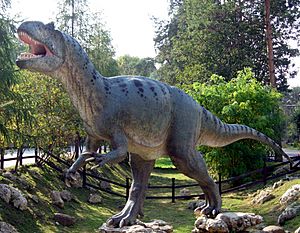
Allosaurus has been in many books, movies, and TV shows. It is often shown as a fierce and powerful predator. Sometimes it's even shown fighting Tyrannosaurus Rex. But they actually lived millions of years apart!
Some famous appearances of Allosaurus include:
- The Lost World (1925): This was one of the first dinosaur movies to feature Allosaurus.
- Walking with Dinosaurs (1999): A BBC documentary series that showed Allosaurus hunting Stegosaurus.
- Dinosaur (2000): A Disney animated movie that included Allosaurus as a predator.
Fun Facts About Allosaurus
- The Allosaurus looked different from other dinosaurs at that time. That's why its name means "different lizard."
- The Allosaurus belongs to the theropod family. "Theropod" means "beast foot."
- Allosaurus had a fairly large brain compared to other dinosaurs its size.
- The bony crests above its eyes might have been brightly colored.
- Allosaurus could run fast! Its top speed is thought to be 30 to 55 kilometers per hour (19 to 34 miles per hour).
- Some scientists think Allosaurus might have been able to regrow lost limbs, like some lizards do today.
- Allosaurus is the official state fossil of Utah.
Types of Allosaurus
Scientists have found different types, or species, of Allosaurus. Here are some of the recognized ones:
- A. fragilis
- A. tendagurensis
- A. atrox
- A. europaeus
- A. jimmadseni
Images for kids
-
"Big Al" at the Museum of the Rockies
-
Restored skeleton of Saurophaganax or A. maximus
-
Skeletons at different growth stages on display, the Natural History Museum of Utah
-
A. fragilis showing its maximum possible gape, based on Bakker (1998) and Rayfield et al. (2001)
-
Allosaurus and Stegosaurus skeletons, the Denver Museum of Nature and Science
-
Restoration of Barosaurus rearing to defend itself against a pair of A. fragilis
-
Locations in the Morrison Formation (yellow) where Allosaurus remains have been found
See also
 In Spanish: Allosaurus para niños
In Spanish: Allosaurus para niños


